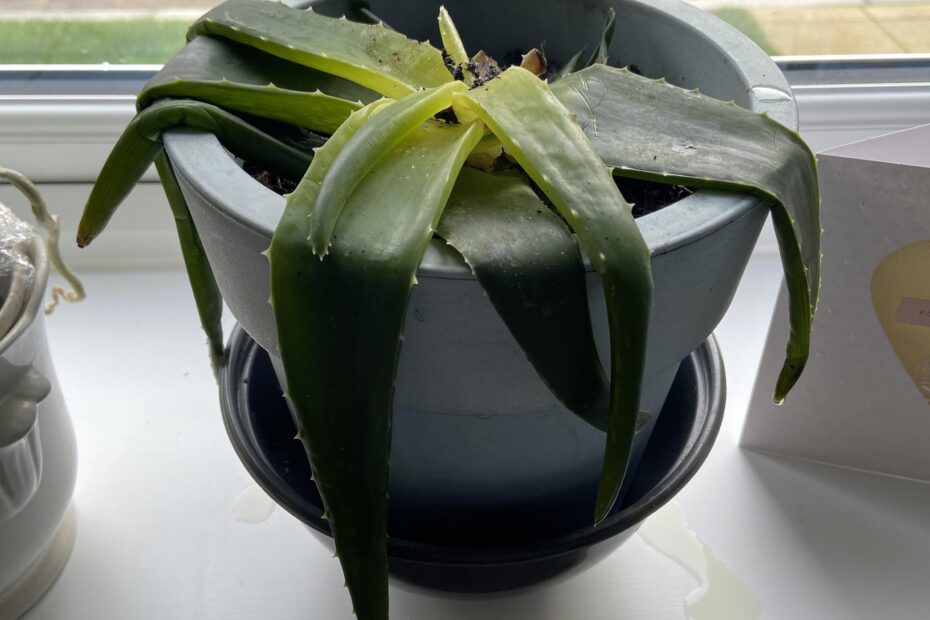The winter winds blow, carrying with them the chilling frost that leaves no plant untouched in its icy embrace. The noble aloe plant, with its soothing green leaves and miraculous healing properties, also succumbs to the bitter grasp of Winter’s languid fingers. But fear not, dear gardeners and plant enthusiasts, for all is not lost! In this illustrious guide, we shall embark on a botanical adventure, unraveling the secrets of reviving our beloved aloe companions after a merciless freeze. With a dash of resilience and a sprinkle of patience, your aloe plant shall rise from its icy slumber, once again flourishing in all its verdant splendor. So gather your gardening tools and let us dive headfirst into the enchanting world of aloe revival after the freeze, where hope reigns supreme amidst winter’s frosty reign.
Assessing the Damage: Understanding the Effects of Freezing on Aloe Plants
Aloe plants are known for their resilience and ability to survive in a variety of conditions. However, when the temperature drops below freezing, these sturdy succulents can suffer serious damage. Understanding the effects of freezing on aloe plants is crucial for reviving them and restoring their health.
When an aloe plant is exposed to freezing temperatures, its cells can undergo severe damage. Ice crystals form in the plant’s tissues, causing them to rupture and break down. As a result, the leaves of the aloe plant may become soft, mushy, and discolored.
| Features | Tips |
|---|---|
| Inspect the Damage: | Start by examining your aloe plant for any signs of damage. Look for discolored leaves, mushy texture, or collapsed stems. Assess the extent of the freeze damage before taking any further steps. |
| Trimming and Pruning: | Cut off any damaged or mushy parts of the plant using a sharp and sterile pair of pruning shears. Make clean cuts just above healthy tissue to promote new growth and prevent any further infections. |
| Provide Shelter: | If you live in a region with cold winters, it’s crucial to protect your aloe plant from freezing temperatures. Consider bringing the plant indoors or providing temporary shelter during extreme weather conditions. |
Reviving an aloe plant after a freeze requires patience and careful attention. Once you have assessed the damage and trimmed away any affected parts, it’s important to create an ideal environment for your plant’s recovery. Keep the aloe plant in a warm location with ample sunlight, but avoid placing it near drafts or heating vents. Water the plant sparingly, allowing the soil to dry out between waterings to prevent root rot. With proper care and time, your aloe plant has the potential to bounce back and thrive once again.

Reviving Your Frozen Aloe: Step-by-Step Guide for Recovery
Has your beloved aloe plant fallen victim to a frosty freeze? Don’t fret, for we have a comprehensive guide on how to nurse it back to green and vibrant health! The winter season can be harsh, but with a little TLC and our helpful tips, your frozen aloe will be revived in no time.
In order to save your frostbitten aloe, follow these simple steps:
| Features | Tips |
|---|---|
| Assessment | Examine the damage to determine the severity. |
| Trimming | Carefully prune away damaged and blackened leaves. |
| Pot Selection | Select a well-draining pot to ensure proper moisture control. |
Once you have assessed the extent of the damage, it is time to carefully trim away any unsightly and dead leaves. This will encourage new growth and prevent further deterioration. After trimming, you’ll want to ensure your aloe has a new home. Choose a pot with excellent drainage to prevent waterlogged roots, an essential feature for a healthy aloe plant.
Now that you have taken the necessary steps to rescue your frozen aloe, it’s important to remember that patience is key. Place your aloe in a warm and bright location, but avoid direct sunlight as it might further stress the plant. With consistent care, regular watering (but not too much!) and occasional misting, your aloe will gradually bounce back to life, displaying its iconic plump leaves in no time. Stay diligent and witness the miraculous revival of your once-frozen aloe!

Protective Measures: Preventing Future Freezing Damage to Your Aloe Plant
Freezing temperatures can be detrimental to the health of your beloved aloe plant. However, with the right protective measures and a little care, you can help revive your aloe plant after a freeze and prevent future freezing damage. Here are some helpful tips to get your aloe plant back to its vibrant self:
Adjust Watering Schedule
- During winter, reduce the frequency of watering as aloe plants need less moisture in colder temperatures.
- Ensure the soil is well-drained to prevent root rot.
- When watering, make sure the soil is completely dry before the next watering session.
Provide Adequate Sunlight
- Aloes thrive in bright, indirect sunlight, so find a well-lit spot near a window to place your plant.
- Avoid placing the aloe plant too close to chilly windows or drafts.
- Consider using grow lights during winter months to compensate for reduced sunlight.
| Features | Tips |
|---|---|
| Well-drained soil | Use a mix of perlite or sand to enhance drainage. |
| Adequate sunlight | Rotate the plant every few weeks for even sun exposure. |
| Insulated containers | Choose containers made of insulated materials to protect the roots from freezing. |
By following these tips and providing your aloe plant with the necessary care, you can help it recover from freeze damage and prevent future freezing damage. Remember, each aloe plant is unique, so observe its response and adjust the care accordingly. With a little patience and attention, your aloe plant will flourish all year round!

Essential Care Tips: Nurturing and Maintaining Healthy Aloe Plants
When faced with the challenge of reviving your aloe plant after a freeze, fear not! With a little extra attention and care, your aloe plant can bounce back stronger than ever. Here are some handy tips to help you rejuvenate your beloved plant:
- Move it to a frost-free zone: If your aloe plant has been affected by a freeze, it’s crucial to relocate it to a warmer area, away from any potential cold drafts. A temperature above 40°F (4°C) is ideal for its recovery.
- Inspect for damage: Carefully assess your aloe plant for any signs of damage caused by the freeze. Look for soft, mushy leaves or a wilted appearance. Trim off any damaged portions to promote healthy new growth.
- Adjust watering frequency: During the recovery process, it’s important to strike the right balance when it comes to watering your aloe plant. Aim for a gentle, yet consistent watering routine, allowing the soil to dry out slightly between waterings. Overwatering may lead to root rot, which could hinder its recovery.
By following these tips, you can give your aloe plant the best chance of survival and promote its revival after a freeze. Remember, patience is key, as it may take some time for your resilient aloe to fully recover. With your loving care and attention, your aloe plant will soon thrive once again, bringing a touch of natural beauty to your space.
| Features/Tips | Description |
|---|---|
| Bright Indirect Light | Aloe plants thrive in bright but indirect sunlight, making them perfect for indoor spaces with good natural light. |
| Drought Tolerant | One of the fascinating qualities of aloe plants is their ability to withstand periods of drought. Their succulent leaves store water, enabling them to survive in drier conditions. |
| Minimal Maintenance | Aloe plants are relatively low maintenance, making them a popular choice for busy plant enthusiasts. Regular watering and occasional fertilizer are usually enough to keep them healthy. |
Frequently Asked Questions
Q: Oh no! My aloe plant got hit by a freeze. Is there any hope for revival?
A: Fear not, frozen plant parent! The resilient aloe vera has a secret weapon up its succulent sleeve.
Q: How can I bring my aloe plant back to life after a freezing encounter?
A: Time to unleash your inner plant magician! With a little TLC and a sprinkle of creativity, your beloved aloe can rise from the frosty ashes.
Q: Any secret tips or tricks to speed up the revival process for my precious aloe plant?
A: Ah, now we’re dipping into the mystical realm of frozen plant resurrection! From cozy blankets to sunlight dances, we’ve got some enchanting tricks up our sleeves to coax your aloe back to vibrant health. As we bring our journey through the icy realms of plant revival to a close, one thing is abundantly clear: the indomitable spirit of nature cannot be extinguished. While the frozen grip of winter may have left your once-beautiful aloe plant in a state of despair, fear not, for hope and rejuvenation are on the horizon.
In this journey, we have discovered the indispensable power of patience and observation, like gentle whispers guiding us towards the hidden secrets of plant recovery. As we thawed the icy shackles, we learnt that reviving an aloe plant after a freeze requires a delicate dance, a symphony of love, care, and a pinch of bravery.
As the first rays of spring sunshine bestow their warmth upon us, it’s time to embark on a journey of revival. With tender care, we have nurtured our aloe plant, coaxing life back into its fragile roots. We have gently trimmed away the frostbitten remnants and nourished it with unconditional love, providing a fertile environment for new growth to flourish.
Though our efforts may have seemed insurmountable, we have befriended our aloe plant, tending to its wounds and offering reassurance that together we can conquer the calamity of winter. Staunch allies in this revitalization quest, we have become guardians of life’s purest essence.
In the face of adversity, our aloe plant has proven its courage, rising like a phoenix from the ashes of frost and despair. Its once wilted leaves, bedraggled and forlorn, now stand tall and proud, dancing in harmony with the gentle breeze. This emblem of resilience embodies the ethos that even in the harshest of conditions, life can fight against the odds and reign supreme.
Now, as a testament to your unwavering dedication, let this aloe plant serve as a reminder of the profound beauty that lies in nurturing and healing. It stands as a testimony to our own unyielding spirit, a reminder that even in the darkest of winters, a ray of hope can penetrate the coldest heart.
So, dear readers, as we bid farewell to this tale of rejuvenation and newfound life, let us part ways with an understanding that our connection with nature is an ongoing dance. May we never forget the power we hold in our hands to revive what seems lost, to heal what appears destroyed, and to witness the wonders of life’s majestic resilience.
Until we meet again on the paths of plant revival, continue to tend to the delicate green souls around you, and may your own hearts find solace in the intricate tapestry of nature’s vitality.
- When to Put Weed and Feed on Lawn in Michigan - October 16, 2023
- When to Fertilize Potatoes Plants - October 16, 2023
- Can You Plant Clover in the Spring - October 16, 2023
Contents
- 1 Assessing the Damage: Understanding the Effects of Freezing on Aloe Plants
- 2 Reviving Your Frozen Aloe: Step-by-Step Guide for Recovery
- 3 Protective Measures: Preventing Future Freezing Damage to Your Aloe Plant
- 4 Essential Care Tips: Nurturing and Maintaining Healthy Aloe Plants
- 5 Frequently Asked Questions

